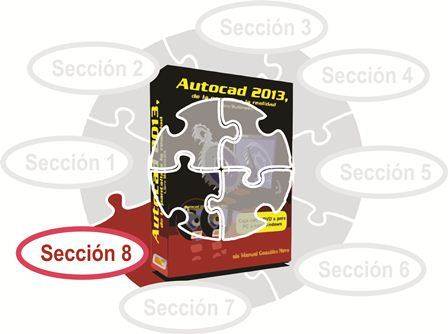3D Drawing with AutoCAD - Section 8

36.1.2 Object references 3D
In chapter 9 we talked about the advantages of Object References and throughout the text we have insisted a lot on it. Here, simply, we must point out that we can activate the references of 3D objects, which will be added to the previous ones. To activate them, we use a button in the status bar. Its contextual menu will allow us to configure them in detail.
36.2 Types of Objects
As we will see later, the various types of 3D objects are interchangeable. From a solid we can generate a surface object, of this one of mesh and of a mesh of a solid object. In all possible combinations and respecting the conversion rules, of course. When an 3D object is of a specific type, it has a series of editing tools that it does not have when it is of another type. For example, the volume of a solid object can be subtracted from another larger solid, through a difference operation, leaving a gap in it. Once this way, it can be converted into a surface object to edit some details through the control vertices and then in a mesh to refine the smoothing of their faces, among a multitude of possibilities.
Define the types of 3D objects that we can create with Autocad.
36.2.1 Solids
Solids are closed objects that have physical properties: mass, volume, center of gravity and moments of inertia, among other details revealed by the Propfis command (which, precisely, marks an error when no solid has been designated).
Solids can be made from basic shapes (called primitives) and then combined, or created from closed 2D profiles. It is also possible to perform boolean operations such as union, intersection and difference.
36.2.2 Surfaces
Surfaces are “hollow” 3D objects that therefore have no mass, volume, or other physical properties. They are often made to take advantage of various associative modeling and sculpting tools. There are two types of surfaces: procedural and NURBS surfaces, which, as we will see, are related to splines, since they can also be modified with control vertices.
36.2.3 Mesh
It is known as mesh objects to those that are composed of faces (triangular or quadrilateral) that converge in vertices and edges. They have no mass or other physical properties, although they share some processing tools with solids and some with surfaces. Their faces can be subdivided into more faces to smooth the object, among other editing features.
36.3 Manipulation of 3D Objects
As mentioned earlier, each 3D object type has its own set of editing tools. However, they all share some commands that, rather than editing them themselves, allow us to manipulate them without the limits of the 2D tools we saw in the 36.1.1 section. Let's see.
36.3.1 Gizmos 3D
In the Modify section of the 3D Workspace start tab we have 3 tools called Gizmos 3D: Shift, Rotate and Scale. In fact, when we select an 3D object, by default one of these gizmos appears in the center point of the object, the one that is configured in the Selection section (and as long as the visual style is not 2D structure). Although we can also select the desired gizmo on the ribbon, of course.
The 3D Shift gizmo allows you to move the selected object or objects by easily specifying the axis or plane (XY, XZ or YZ) by which we want to move the object. To do this, add an SCP icon to the base point of the scroll. This and other gizmos can also be used with 2D objects.
Rotation 3D, as its name implies, allows you to rotate the selected object or objects using the same procedure, ie the axis signaling of the gizmo itself. Then we can indicate an angle in the command line window, or use the mouse. However, rotation is restricted to the selected axis.
Finally, Scale 3D resizes the object or objects as a whole (so it is not possible to restrict it. Scaling factor can be captured in the command line window, or interactively indicated with the mouse, perhaps using object references To bring the object to the desired size.
We must add that the context menu of the gizmos allows us to switch from one to another gizmo and, in the case of Shift and Rotation, choose the axis or plane to which we want to restrict the action, among other possibilities.

